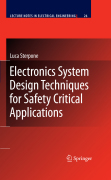
Electronics system design techniques for safety critical applications
Sterpone, L.
The main purpose of the present manuscript addresses the development of techniques for the evaluation and the hardening of designs implemented on SRAM-based Field Programmable Gate Arrays against the radiation induced effects such asSingle Event Upsets (SEUs) or Soft-Errors (SEs). The perspective of the analysis and the design flows proposed in this manuscript are aimed at defining a novel and complete design methodology solving the industrial designer’s needs for implementing electronic systems using SRAM-based FPGAs in critical environments, like the space or avionic ones. The main contribution of the proposed manuscript consists in a new reliability-oriented place and route algorithm that, coupled with Triple Modular Redundancy (TMR), is able to effectively mitigate the effects of radiation in SRAM-based FPGA devices Novel FPGA design-techniques Reliability-oriented Place and Route Algorithm Placement Optimization Algorithm Static Architectural Analysis INDICE: Part I Fault Tolerant Systems on SRAM-based FPGAs. 1. Introduction. 2. Radiation Effects on SRAM-based FPGAs. 3. Analytical Analysis of SEU effects on SRAM-based FPGAs. 4. Reliability-oriented Place and Route Algorithm forSRAM-based FPGAs. 5. A Novel Design Flow for Fault Tolerance Systems on SRAM-based FPGAs.- Part II Applications for Reconfigurable Logic Devices. 1. Decompression Systems. 2. Biomedical: Analysis of DNA microarray. 3. Multimedia: A new Reconfigurable Architecture.- Part III Concluding Remarks.- Bibliography.
- ISBN: 978-1-4020-8978-7
- Editorial: Springer
- Encuadernacion: Cartoné
- Páginas: 200
- Fecha Publicación: 01/11/2008
- Nº Volúmenes: 1
- Idioma: Inglés
